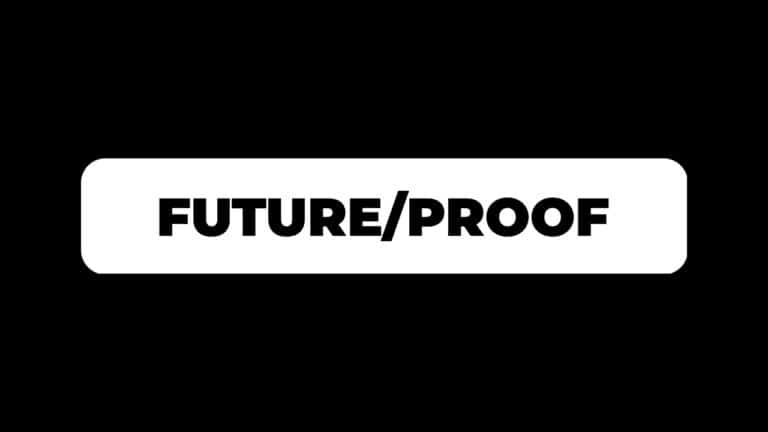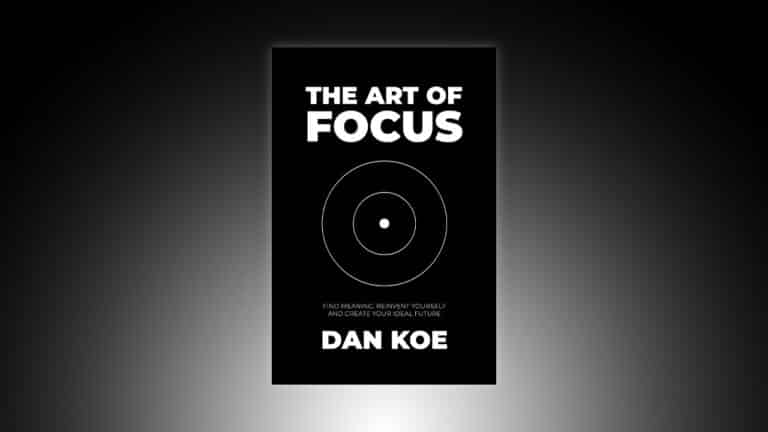3-6 months.
That’s how long most creators are trapped in beginner hell.
You know, that dreadful place where you feel like you don’t know what you’re doing. You question whether it’s worth it to keep going. You’re thinking of what you’re going to try next (just to do it all over again). Unfortunately, most people quit before things start to get good.
But understand this:
Most people think the answer is to “just be consistent.”
To keep pushing through even when you aren’t making progress.
Zero likes. Zero followers. Zero sales. It’s one of the most painful things in the world. Becoming a creator was supposed to be your ticket to the good life, wasn’t it? Or was it all just a scam? A pipe dream sold to you by marketers and gurus?
Here’s the brutal truth… you aren’t making progress because you aren’t doing the right things.
So before you go back to the life of comfort you swore to leave behind, listen to what I have to say.
You need to reach the point where everything “clicks.” You need that “aha!” moment where clarity strikes and you know exactly how to break through to intermediate heaven.
I know you’re on the edge right now.
But remember why you started.
You know you want to do something creative.
You know you need an audience to do that outside of a job.
You know you want to be in control of the money you make and the lifestyle you design.
You know that, in order to do those things, you need to write or create. You need to become your own media company that attracts people to your independent work. Your self-published books. Your music. Your ideas. Your expertise.
You just need to reach that glorious moment—the “click”—and you will finally feel in control of your future.
Let me help.
How To Escape Beginner Hell
All overnight success takes about 10 years. – Jeff Bezos
Now, there is a series of actions you can take that will lead to results.
Plain and simple.
But most creators mindlessly follow the instructions they were given in a video, course, or article.
My friend, this isn’t a job with a linear set of steps you can perform everyday, shut your mind off, and live like you always have. This is a one-person business. You are the CEO. You are the CMO. You are the COO. You are everything. Please start acting like it. Get it together.
I know because I was in beginner hell for almost 5 years.
I jumped between dropshipping, 3 ecommerce stores, digital art and photography, a Facebook ads agency, an SEO content agency, and eventually had to get a job in web design because the loans were piling up and I wasn’t willing to drown any longer.
At my job, I procrastinated all my work to make freelance web design work. When I started writing on social media to land more clients, I didn’t experience a beginner hell because I knew how to avoid it.
The skills I learned along the way led to my own “click.” I’ll tell you what those are, but they involve:
- A different way to think about finding your niche
- The best type of content to bring in followers
- How to monetize without relying on platform ad revenue
- Why you should forget building a funnel because social media has changed
And much more that I’ll leave to your imagination. I am going to give you a condensed social media masterclass so you can finally feel like you have control over your life’s work. I am going to tell you how to end up like this guy:
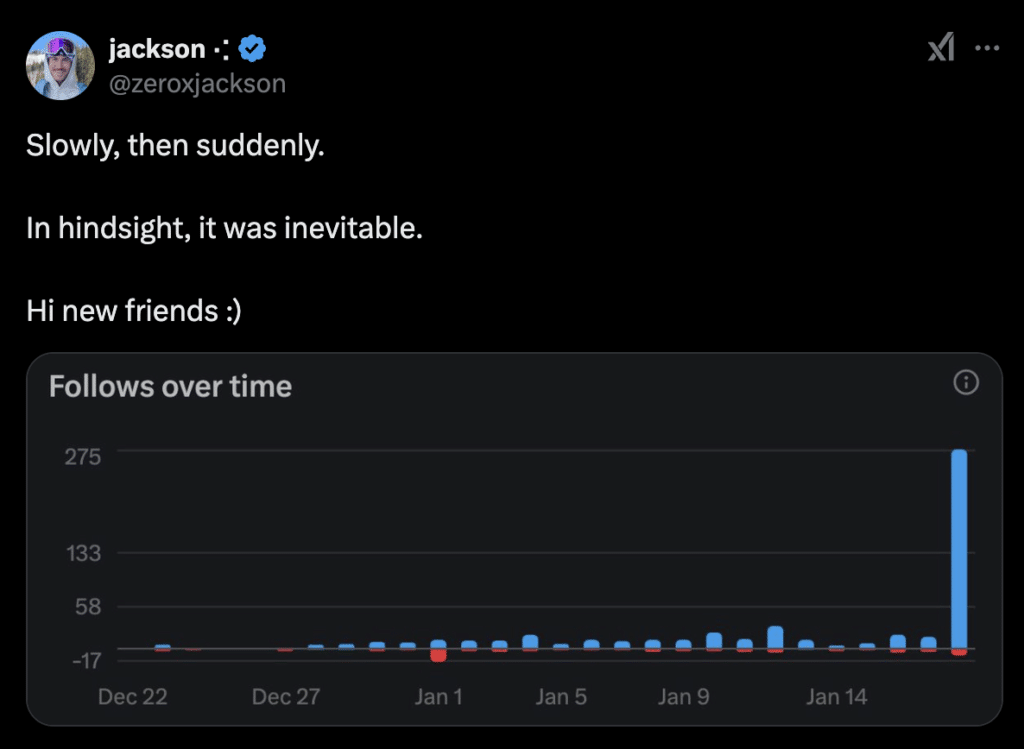
After teaching writing and content to almost 30,000 students, here are the 7 tips, strategies, and insights that will change everything for you:
1) Do What Works For Beginners
Beginner hell can last anywhere from 3 months to 30 years.
For some people, it lasts their entire life (starving artists).
Why?
Because beginners don’t realize what advanced creators do now is not what they did to grow in the first place.
And that’s the most important point of this letter:
You aren’t growing because you aren’t doing the things that lead to growth.
Beginners start posting philosophical quotes or try to be the next Marcus Aurelius when nobody knows who they are or cares about what they do. They have no authority.
I hate to break it to you, but you aren’t a Roman Emperor.
You aren’t respected because nobody knows who you are.
That means you have to build authority on social media before people care about your cute little fortune cookie posts.
How do you build authority?
1 – Solve more problems.
80% of your content as a beginner should start with a pain point.
If you are just writing ideas without any second thought, you aren’t going to go very far. You need to be meticulous with the structure of your posts at the start.
With every idea you want to write about, think about a pain point that the average person faces. Start with that in your content.
Use phrases like:
- “Most people” – i.e. Most people suck at writing.
- “If you struggle with” – i.e. If you struggle to focus for more than 5 minutes.
- “The worst” – i.e. The worst skill you can learn is web design.
I use these quite often in my content because they work.
Problems capture attention. Problems open a curiosity loop. Problems make it 100x easier to make the rest of the post impactful.
Start with the problem, then finish it with a list of steps, your unique perspective, or a novel insight.
2 – Cover the most important ideas in extreme depth.
Once you pick a topic, you don’t just start writing random ideas.
There are a select few evergreen ideas that always perform well within that topic. It’s up to you to find them and write everything you can about them under your own brand.
In something like building a business, those ideas are:
- How to choose a niche
- The best business model for beginners
- The best skills to learn
- How to make X amount of money in Y amount of time
There’s a reason you see these topics being talked about all the time.
Because they WORK. They work because 95% of the market are beginners. They work because nobody can get sick of the fundamentals.
Stop trying to avoid writing about the things that people want to learn about.
“But Dan, everyones talked about these things before, why would they care about me when I do?”
I need you to zoom out a bit. You’re in beginner hell so it’s easy for your mind to fall into survival mode and not be able to think straight.
How many times have you read about those topics from different people? Do you care?
No. Because people need to be reminded more than they need something new.
Once you know what topic you want to write about, research 5-10 accounts that talk about that thing. Notice what content they repeat on a weekly or monthly basis. Notice what content they all talk about.
Then, make it a consistent part of your brand.
Create multiple free guides around those topics.
Create content about one of them at least once a day.
Write short, medium, and long form content. Posts, threads, carousels, newsletters, and the rest.
You need to create a world of content so people can dig as deep as they want into your brand, but that’s something we’ll talk about in a later point.
3 – Filter your favorite accounts to find their oldest content.
Chances are, you are copying feel-good ideas from big accounts.
They already have an audience. They already have a high baseline level of engagement. You have no idea if those posts will work for someone with no authority or skin in the game.
James Clear can write anything and get thousands of likes. You can’t. Why? Because James has an absurd amount of time in the game and has published a serious amount of value. All people need to do is read his book and they’re a fan. You haven’t written a book, nor do you have the 1 million subscriber email list from blogging that made his book a success in the first place.
Study what content people created in order to grow. Look at their oldest posts and keep scrolling until you find some posts that did better than others.
Most people went through their own beginner hell, then they had 1-2 moments where they gained a bunch of followers at once. Find those.
2) Your Content Isn’t That Good
Frankly, if you aren’t growing, your content just isn’t that good.
You can’t just pick a topic and start writing.
You need to take the reader’s psychology into account.
You need to become a dopamine dealer.
You need to capture attention, hold attention, and deliver value.
Most people think they are doing this, but they aren’t. They write a post and send it without any second thought or questioning whether it’s actually good.
All of those require a lifetime of study within themselves. Hell, even I need to refresh myself on how to do them every month or so.
I’ve written a previous letter on the 10 Koemmandments of Engagement, so read that if you want to go deeper with examples, but I’ll list them here so you can practice.
I would highlight recommend writing these down. You can download the Kortex desktop app, open floating capture with Option+C, and take notes as you read.
1) Specific Numbers
Use specific numbers in your hooks or headlines like “Apples new $1175 iPhone has this new feature.”
Example:

This works because it acts as a pattern interrupt (the added authority helps too).
2) Pattern Interrupts
A pattern interrupt is something that breaks people out of their normal conditioned patterns.
On social media, people are scrolling through mostly boring text and images. You need to do something different that makes them stop their scroll.
3) Negativity Bias
The human brain is wired to remember and pay attention to negativity.
This doesn’t mean you need to be negative, it means you should position some of your writing in a negative light (it can still be positive).
“You are going to achieve great things.”
Compared to:
“You will never hit rock bottom again.”
The second is a lot more potent.
4) Target Callout
This is simple, call out the specific person you are talking to.
- If you are in your 20’s…
- Calling all creators, coaches, and freelancers!
- Fathers are a gift to humankind…
Even if your audience doesn’t fall into the specific group you are calling out, it will allow them to “pick a side” and compare themselves to what you are saying.
5) Problem Callout
We talked about this one, but as a crucial reminder:
Start with the pain point.
6) Potential Benefit
One of the most important questions you can answer for your readers is “What’s in it for me?”
If you ask yourself that question after reading over your content, most people will find that their content lacks any tangible value. You have a cool idea, but people don’t care about it.
Rewire your mind to think in problems and benefits.
Start with the problem, imply a desirable transformation with a benefit.
7) Social Proof
When you flex your results, experience, or credentials, people assume that you know something they don’t, and they want to continue reading or following.
Justin Welsh is great at doing this without being cocky:

Talk about your results.
AI can’t compete with your results.
Whether you’re a writer who finished a chapter of their book or a health nut that lost 20 pounds, share your experience. I’m sharing business screenshots because that’s what I have sitting around, but there are plenty of examples in the productivity, health, relationships, or self-improvement in general space. Numbers aren’t only money.
8) Confidence & Conviction
This is my favorite point because many people refuse to have conviction in their beliefs. This makes it quite easy to stand out if you can reconcile the phrase “firm beliefs held loosely” in your mind.
- Eliminate words that imply uncertainty
- Speak in absolutes when possible
- Exaggerate your point to add energy
Of course, do not abuse these for the sake of engagement.
Rather than saying:
“It may be wise if some people developed their skillset.”
Say:
“It is crucial that everyone on planet earth develops their skill set.”
Here’s a good example:

I wrote this post almost 5 years ago now.
That was the first post that brought me almost 600 followers as a beginner.
Because of that, I kept talking about it, turned it into a thread, then a YouTube video (after 2 years, I focused on one platform at the start), and it is my most viewed video on my channel.
We will talk about how to make noise and double down on signal in a later point.
9) Punch, Rhythm, & Readability
Start short and to the point.
Then, just like this, continue on with your idea.
- Use line breaks
- People love bullet points
- You can get as creative as you’d like
Do you notice how I am guiding you down the page?
How I start short, keep you engaged, and deliver a hint of value?
Even the bullet list is ordered from the shortest point to longest.
10) Warnings & Caution
Read this post:

I start with warning people about a trap. Then I tell them why.
This is an incredible way to write engaging content because every topic has a large list of traps that people can fall into. If you can identify what those traps are, you have a list of great content to write.
You don’t need to use all 10 Koemmandments at once, but I would urge you to have this list open while writing. Before you hit send, ensure that you have at least 2 for short form content and even more for long form content.
By the way, I talk about all of this in 2 Hour Writer.
3) Start With Training Wheels
Most people don’t have an idea problem, they have a structure problem.
Because here’s the thing:
Any idea can go viral if and only if you structure it the right way.
Generating ideas isn’t hard. You just passed by at least 50 in this newsletter so far that you could take and run with.
The problem is, you don’t know how to structure them.
You haven’t trained your mind to masterfully articulate ideas in an impactful way.
Once you do that, you can turn even the worst idea into something that people can’t stop reading, watching, or listening to.
Like any other skill, you need to start with training wheels. Here’s what you do:
1) Create a swipe file.
If you want to be a creator, you need to keep your finger on the pulse of the market.
You need to scroll social media not as a consumer, but as a researcher.
Whenever you see a viral idea that makes you think, “Damn, I wish I wrote that.” Save it. Copy the link into Kortex capture and organize it into a “Swipe File” document by typing “@.”
Think of your brand as an amalgamation of the ideas you love, the ideas that impacted you most, and the ideas you want to be included under your brand.
Now, you can use those ideas as inspiration, but that’s not the full point.
You are saving these content pieces so you can emulate the structure.
Let’s take this post from before as an example:

You can see a clear structure:
- Broad hook with a desired outcome and specific number
- 5 exaggerated and polarizing steps in a bullet list
- Additional context that answers the objection “well I can’t disappear completely! I have friends and family!!”
- Last line that ties everything together
So, if I were to plug in a different idea that I got from a random book like, “meditation is running for the mind” I could turn it into something completely new:
How to clear your mind in 60 seconds:
- Lock yourself in a room
- Sit in the corner
- Breath deep into your belly
- FEEL the breath with all senses
- Repeat for one minute
Any time you get distracted, refocus your attention on the breath.
“Meditation sprints” are how you achieve calm, fast.
If you want to get more creative with it, use the 10 Koemmandments above to change out the hook and let that shape the post more.
Instead of “How to clear your mind in 60 seconds,” I could focus on a pain point, statistic, target call out, or spin it in a negative lens like “How to destroy negative thoughts in 60 seconds.”
Yes, this requires you to think and sit with the idea.
The goal here is to practice this so much that it becomes second nature. You start writing texts to your mom in a persuasive way. You start speaking in a way people want to listen to. The benefits of this go far beyond gaining a few followers.
Last, don’t just do this with tweets. You can study long videos, short videos, or anything else relevant to the type of content you want to create.
If you want a swipe file with 77 post templates, here’s my idea museum.
2) Study writing frameworks.
When I first started writing, frameworks were a lifesaver.
I read the book Ca$hvertising and learned the basics of frameworks like AIDA (attention, interest, desire, action).
As I got deeper into copywriting, I learned about PAS for short-form promotions and PASTOR for long form sales letters.
It’s safe to say that by using these for my writing, not only could I write faster, but I felt confident that I was being attention grabbing and persuasive.
Along with your swipe file of content, research 5-10 copywriting frameworks.
You can use ChatGPT (or Kortex AI next month) for this if you’d like.
Or, if you want another template to continue filling up your second brain with useful notes, here is an explanation of the Pain & Process framework.
3) Have them open as you write.
I say “write,” but this applies to all types of content.
If you write the script for your reels, TikToks, or YouTube videos first, you gain physical control over your articulation. You can see the hook, the sentences, the ideas, and move them around like legos until they’re beautiful. Don’t go into content as a beginner blindly.
- Capture ideas throughout the week
- Sit down 2-3 days out of the week for 1-2 hours
- Open up Kortex or another writing/notes software
- Paste in your content frameworks
- Open them in a pane on the side
- Write out your ideas and reference the frameworks
You’re not copying the other people’s ideas. You’re emulating the structure that makes them do well.
4) Nobody Knows Who You Are
You have good content.
You know your ideas hit hard.
You’re writing all day every day, but you still gain maybe a few followers a day, max.
What’s the problem?
Nobody knows who you are.
You’re just waiting for your lord and savior the algorithm to launch your posts to the moon when that’s not going to happen. And even if it would, you should act like it wouldn’t. Your growth is on you. It’s in your control… if you know what you’re doing.
You see, content is one small part of the social media equation. Especially as a beginner.
The bigger part of the equation is:
- The amount of people who know and like you (because they’re more likely to share and engage with your posts)
- The amount of people who see your posts (because almost nobody will as a beginner)
- The quality of friendships you make with those on the rise (because they’ll pull you up as they grow)
If you have 500 followers and get reposted by someone with 500,000 followers, your audience is now 500,500 followers.
This is how people make tens of thousands of dollars with a small audience. They know how to network. They know how to get their content seen beyond their audience.
Beginners think they are limited to their follower count and the algorithm is how they grow.
Experts know they can access their own followers and their network’s followers. They write a post they know will bring in followers or sales and have 10-15 people share it. This isn’t something they do every day. It is strategic. They build up good will and act right when the time is right.
Sahil Bloom is someone to watch who is doing this right now. He has his book, The 5 Types Of Wealth, available for preorder (it’s going to be a best seller, easily, by the way, not because he has a large audience, but because he is smart). He is working day and night to get his books in as many hands as he can. He is sending free copies to at least 50 people on X, bookmarking pages for them to post that will go viral, and commenting on them with the link to the post. He has 1 million followers, but if I had to guess, these posts have been seen by 100 million people.
I’m rambling.
What can you do?
1) Inject yourself in a tribe.
The most basic social media advice is to “reply to large accounts a bunch.”
This works, and is important, but most people don’t know why they are doing it beyond getting a few impressions on their replies hoping that some will follow them.
In reality, you’re doing a few things:
- Writing quality replies (not “Great post!” or repeating what they said with ChatGPT) so people have a reason to look at your profile and follow you. Again, 10 Koemmandments.
- Becoming well known to a tribe of people. If I wanted to break into a social media circle, like the startup circle, I would simply reply to 10 great accounts in that space by adding value and personal experience. The consumers in that space get used to your face and follow you after they see you enough, not after your first reply.
- Seeding connections. The more you reply and DM people within a certain niche group, the easier it is to DM them, or have them DM you. They will engage more with your posts and feed you opportunities.
Reply strategically.
2) Practice non-needy networking.
It’s a shame this has to be taught, but it does.
People no longer learn social skills in their everyday environment.
People are as afraid of DMing other people as they are saying hi to a random person on the street.
In reality, it’s as simple as finding a shared interest.
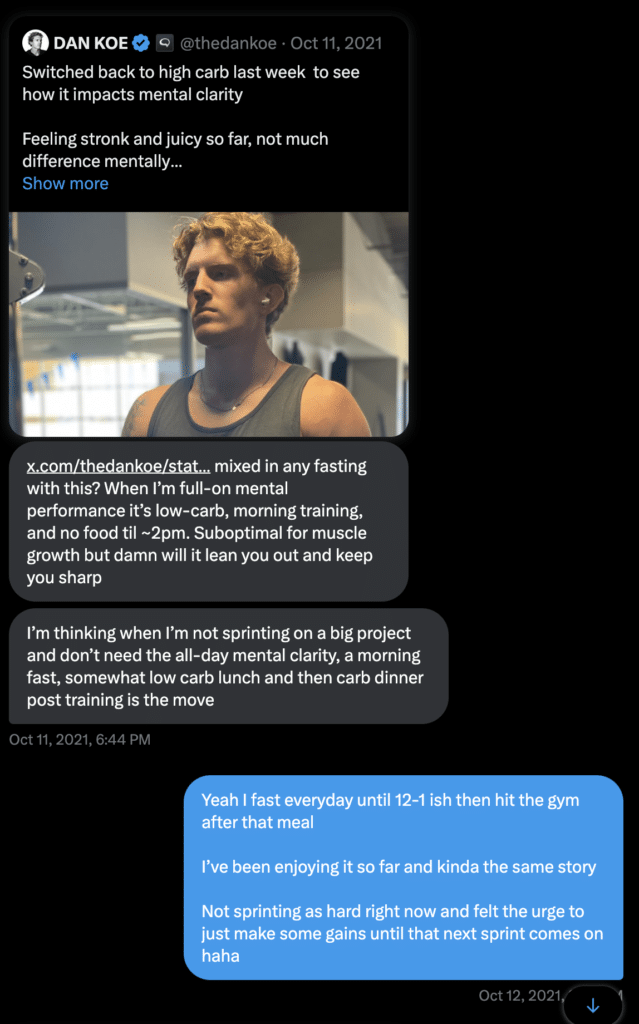
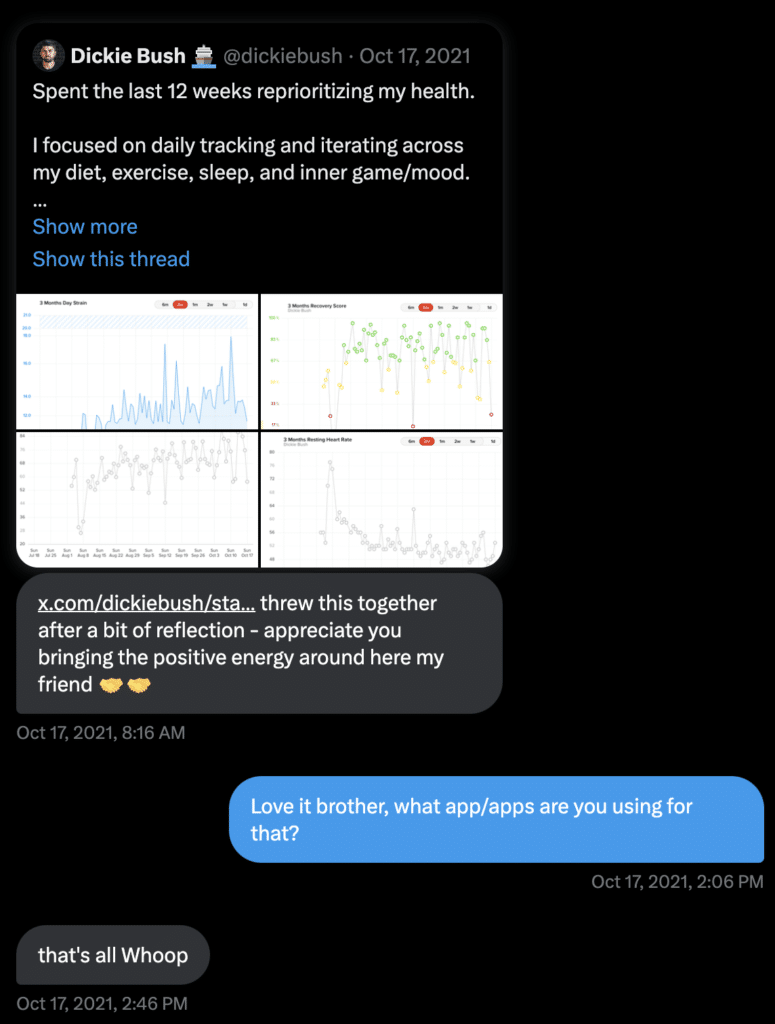
It’s literally that simple.
Guess what I did on that thread he shared? I reposted it. Because I had a new friend and he was smart enough to send it.
Here’s another Kortex doc with 7 non-needy networking steps if you want to add it to your workspace.
Send a compliment or question about their content. Talk for a bit. Then do this:
3) Plan one strategic post a week.
If you are only posting content, you will not grow.
Plain and simple.
And if you do grow, the algorithm will eventually change, and you will be floating off in the ocean without a support network.
You need to be having conversations every week. You need to be writing posts that add value to those conversations and sharing them with those people.
5) You Need A Product
Most creators wait to monetize until they hit some imaginary follower count just to be disappointed when nobody buys.
Or, they think that they’ll make a decent income from platform monetization (like YouTube) until they hit a wall and their views plummet for 2 months.
The point is, if you want to be in control of your income, you need to sell a product or service.
This does a few things:
1) People start to see you as an authority.
Most creators build an audience of people that don’t care about them.
They don’t realize that content isn’t enough to build a deep connection with someone. People need to invest in you in order to pay more attention to you.
People aren’t on social media to learn and adopt new habits. They buy products for that. And once you change their habits, or change their life, they will hold you much higher in their mind.
Many creators plateau simply because they have a surface level audience.
2) It gives you a frame and incentive for your content.
If you don’t know what to write, write about a topic that solves a pain point related to the product or service you sell. Simple.
On top of that, many people don’t have a reason to continue creating content because there is no immediate reward.
If you have a product or service, you at least have the potential to make some money from it. You’re able to focus your efforts on the things that get results.
3) It makes trial and error more tolerable.
If something isn’t working, you know it isn’t working.
You aren’t getting clicks. You aren’t getting sales.
If you aren’t getting clicks, write content based around more pain points and get it spread to more people with non-needy networking.
If you aren’t getting sales, study offer creation and copywriting to convert more people.
If you don’t know where to start with a product or service, I show you how to build an “MVO” in the One-Person Business Launchpad.
6) Build A World, Not A Funnel
Gone are the days of countdown timers and fake scarcity.
Today, creators are building worlds, not funnels, although a simple newsletter and landing page can be considered a funnel. In that case, you’re building a world of mini funnels.
The average consumer doesn’t trust people out of the gate. You need both time in the game and enough value for them to explore in order for them to gain trust.
You need to build a small scale Marvel cinematic universe. You need to build movies, action figures, and lore that people can binge.
In other words, you need:
- Short form content (X, LinkedIn, Instagram, Threads, or TikTok)
- Long form content (newsletter, podcast, or YouTube)
- Free guides (ebooks, templates, video trainings)
- Low ticket product (course, template, cohort)
- High ticket product (coaching, freelancing, consulting)
Start with one short form and one long form. I recommend X, LinkedIn, or Threads combined with a newsletter. Then, you can use those newsletters as YouTube scripts and cross post your short posts to all other platforms and use the best as reel or TikTok scripts.
Then, once you build enough distribution and cash flow, you have the resources to pivot into something like eCommerce or software.
Social posts are the new MVP.
Post a bunch. Turn the best into newsletters. Cross post those everywhere. Turn the best of the best into a digital product. Refine it until sales are high. Turn that system into a software, or compliment it with a physical product.
7) Make Noise, Double Down On Signal
The last objection:
“But Dan, I want to write about my ideas in an authentic way. This whole social media thing feels so soulless and templated.”
I agree.
But to handle the first part, templates and frameworks don’t make you inauthentic. Creativity thrives with constraints, and a framework allows you to express your authentic ideas in a way that other people care about.
If you want to be purely “authentic” without regard for what others think, that’s great, but good luck being able to sustain that as a lifestyle that pays you. Not that money is the end all be all, but it is important, and it’s only as evil as the person who wields it.
For the second part, you can write about whatever you want.
You don’t have to fall into the trap of only writing content that performs in the algorithm.
You should make room for both. Content that you know will expose you to more people, and content that you think those people will love.
But if people don’t find you first, they don’t have a chance at seeing your other, deeper, ideas.
So, feel free to make a lot of noise.
Write about any idea your heart desires.
Pay attention to the ideas that people resonate with.
The ones that get slightly more engagement, DMs, or followers.
Then, incorporate them as a consistent part of your content strategy.
You don’t need to choose a niche. You need to experiment with ideas until people tell you what niche best suits your relationship with your audience.
If you want to learn more about my “you are the niche” philosophy, here’s a previous letter.
Thank you for reading.
– Dan

